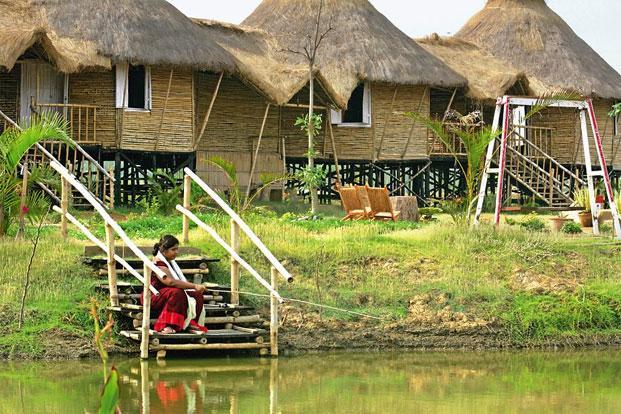
From the cottage veranda, you can see the waters of the Bagda river, wooden boats moving lethargically with the flow of the current. In the distance, figures nimbly weave cane slivers under the branches of a large shaded tree. Birds sing in chorus from dawn to early evening. And the hooting of owls keeps you company after dark.
For those looking to tune out of city life and align with the thrum of rustic Bengal, this makes for an ideal weekend break from Kolkata.
Tucked away in the heart of Paushi village, about 150km south-west of Kolkata, Mon Chasha is an adventure in alternative tourism. Six roomy cottages with bamboo furniture, created by Nilanjan Basu, an eco-tourism entrepreneur, and his wife, fit seamlessly into the village ambience. The otherwise modern bathrooms have gamchhas (thin cloths) rather than towels. Mon Chasha is solar-powered and water from the kitchen and bathrooms is recycled and used in the gardens.
Villagers here are engaged in a range of occupations, from fishing to basket weaving and cane craft. Young tourists can play games such as guti khela, guli danda, bagh-bandi, luko-churi, jor-bijor and ekka dokka. The cottages, poised on casuarina or jhau stilts, have creaking floors. And at the end of a sloping jetty waits a red, black and white boat, ready to take you for many rides up and down the river or to places nearby. The evening brings puppet shows or wandering Vaishnav singers who sing kirtans by the lantern light.
Paushi hosts a haat (market) on Thursdays and Sundays, with stalls filled with colourful vegetables like lal saag (red leafy vegetable), coconut and betel leaves. Its fish market is known for the quality of prawns, not to mention the tangra, bhetki and pabda fish. The Bagda’s water is salty for the greater part of the year, turning fresh and sweet only with the monsoon rain.
Most of the local produce goes into Mon Chasha’s cookpots. Food at the resort is traditional and hearty, guaranteed to induce afternoon siestas. You can breakfast on luchi and alur torkari, lunch on prawn malai curry and generally enjoy the wealth of Bengali fare, including the almost vanishing goyna bori, edibles made of lentil paste and shaped like jewels.

Near Paushi is a potter’s village which is at its busiest as the Durga Puja festival approaches. You’ll find it packed with pots of all shapes and sizes waiting to be fired and painted. If you’re lucky, you will even find one ready to buy. Hop on to the back of a cycle van—mind your legs though, the roads are narrow—and trundle down to the old temple of Sarpai Sarbamangala, 4km away. Though the temple itself is in ruins, the presiding deity is rumoured to be immensely powerful. She takes the shape of a block of stone with eyes set in it and a red slash of sindoor. Even the stones by the ghat have a kind of dark energy to them—and you might remember that Bankim Chandra Chattopadhyay set his novel Kapalkundala in the dark-green depths of the region.
Life at Mon Chasha is as slow as the shadows passing over the fields. The village folk are curious and friendly, full of directions to the best places to buy pots and bamboo work. Responsible tourism— sampling the folk games, the local food, using solar-powered amenities, etc.—is the focus, and balance the name of the game.
[Source:-Livemint]






